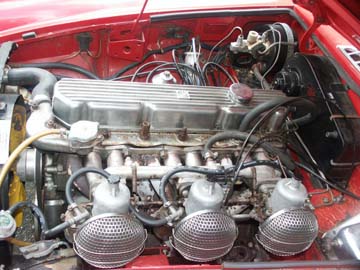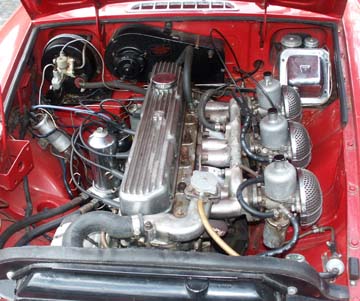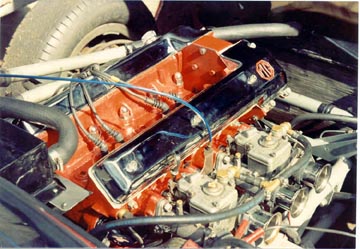Giving up on Webers for my "Race engine" TR6-Dio Tipo build.
Started looking for simpler HS6/1.75" and found prices high for very questionable units.
Found some rebuilt HS8's at a good price.
I know I would have to open up the intake another .250", not a problem as I have a vertical mill and boring bar.
Of course I can see looking at the intake I have that a bit of blending would also be required.
Intuitively 2" SU would seem a good upgrade but I am hoping someone here has experience with such a swap?
Partly looking to be rid of the limited emissions control carbs as well as performance gain.

NOHOME
MegaDork
7/1/23 10:52 p.m.
My thoughts are that you want to match the carb flow with the engine's vacuum flow. If the engine can only suck so much, having excess aperture just makes for a lazy response.
I ran 2" SU carbs on an MGB and while they worked ok at speed, when cranking the engine, they barely provided enough air flow over the jet to tease the fuel out of the jet.
Hmmm, 2.5L six with fully ported head and high compression vs stock? 1.8 four.
TR forum says yes, I think I will go for it.
Still open to additional comment.

Tom1200
PowerDork
7/2/23 12:06 a.m.
In reply to RichardSIA :
Have you looked at the Mikuni or Keihin flat slide set ups??
Rebuilt HS8's $200 and I expect they will take original linkage.
Mikuni fit? and $?
This is also supposed to remain a Vintage Race type build.
One of my Do or Die Trying builds, ASAP.
My only experience with HUs was installing a small pair on an old Formula Vee 1600 that I autocrossed. I had a copy of David Vizard's book on tuning A-series BL engines and it had some tips on increasing airflow through HUs. All I remember is knife edging the throttle plate to increase flow. There were other hints in there as well.
In reply to Tom1200 :
Im a "small motors" guy, the flat side slides are nice and highly tunable for little $. I use Keihin knockoffs, i think you could set them up for a small displacement auto engine.

wspohn
SuperDork
7/2/23 11:03 a.m.
A more productive way to go, if rules allow it is triple carb. Much more direct feed to the ports and triple 1 3/4" will work well. This is the set up I built for an MGC - triple 1 3/4" SUs on a manifold I created from 1 and 1/2 late model TR4A intakes cut and heli arced together. Added 15 mph to top end.


Two 2" SUs would be 12.5 in² of area, while triple DCOE 40s have 30 in² of area. A properly setup TR6 can use the triple Webers, so I'd say it could work. But I agree with wspohn, triple 1.75" SUs would be better. You can improve the flow of a stock TR6 manifold, but it will be somewhat uneven across cylinders unless you have a flow bench and lots of time.
GoodParts sells a triple intake for Stromburgs/SUs.
Webers are going to be over $1,500 even if I can find a "Narrow Port" intake.
Twin HS8's about $400 and a little of my time.
For some reason HS6 prices are high, new or used.
The Goodparts intake is $500 plus finding three HS6's and rebuilding them, so not a lot less than the Webers.
There is also a time factor here, I feel like I am running out of time too rapidly.
HS8's are bought, paid a little more than I am happy about but should be a "Simple" solution.
In reply to wspohn :
I like the home-brew triples, I just need to do something quicker than I could make that happen.
I forgot to square my Rs (which doesn't matter when R=1) and threw in a extra factor of 2. So the numbers should be 6.27 in² for 2" SUs and 11.7 in² for DCOE 40 Webers. It should still work, and a constant depression carb will self-adjust better than a Weber. Post pics of the progress.
From a poster at the Triumph site, "I've run 2" SU's on my GT6 both with the 2.0L and the current 2.5L engines. I don't have any direct dyno comparisons to the smaller carbs, but I can say the big carbs perform wonderfully. Starting/ idling/ cruising/ wide open max rpm performance are all very nice".
I did not think this would be breaking new ground.
Here are a pair on a TR6.

On a straight six, dual carburetors will receive a suction pulse every 240* of crankshaft rotation. Triples will have a 240*-480* alternation. It'll probably be a lot easier to get duals to run well.
SUs are constant vacuum so throttle response even with big carburetors should be good. I say go for it.
Intake ordered today.
Need to assemble the engine.
Need to find a cam, not stock but not too wild, as I do want to be able to street this car.

wspohn
SuperDork
7/4/23 11:58 a.m.
You should be able to make them run alright - Rover managed it on the Rover 2000 TC though God only knows why they thought they needed those on a 2.0 street car. MG made a mistake when the homologated twin 2" on the MGBs. Too big and gave lots of problems - they'd have been as fast with twin 1 3/4" .
This is what I ran on my MGA race engine - but it is 1950 cc not 1600 and more......the pic shows it in my TVR Grantura Mk 3 as it was easier to get at than in the MGA race car.

wspohn said:
A more productive way to go, if rules allow it is triple carb. Much more direct feed to the ports and triple 1 3/4" will work well. This is the set up I built for an MGC - triple 1 3/4" SUs on a manifold I created from 1 and 1/2 late model TR4A intakes cut and heli arced together. Added 15 mph to top end.


WSPOHN is right. The curves on intakes kill power.
On the Jaguar 6 cylinders cylinder Webers make 15 more horsepower than 3 HD8's I. Back to back tests.
The Webers are straight flow and the HD8's have a S curve to follow to get in.
A while back when GRM was testing intakes the found that to be true. It's true because each change of direction of flow reduces power.
RichardSIA said:
Intake ordered today.
Need to assemble the engine.
Need to find a cam, not stock but not too wild, as I do want to be able to street this car.
Cam grinders are your best friend in this regard. But you have to give them actual numbers to work with. So go have someone flow your head. And the intake manifold you'll be using. It's not horribly expensive they just hook it up to a flow bench and record the numbers.
If you have actual numbers You can avoid wasting energy opening valves more than is needed and select the right valve springs for your application.
Without them it's a guessing game.
Oh, they can sound very reassuring But they will need to leave things on the table. Because it's a guess
You didn't build your engine by guessing what the clearances and torque should be. Do select the thing that makes it all work by guessing either.
chaparral said:
On a straight six, dual carburetors will receive a suction pulse every 240* of crankshaft rotation. Triples will have a 240*-480* alternation. It'll probably be a lot easier to get duals to run well.
SUs are constant vacuum so throttle response even with big carburetors should be good. I say go for it.
I'd have to see the firing order but I suspect if the cylinders firing (Per carb ) are 240/ 480
That will give a strong signal because as one closes the other opens. Thus flow through the carbs would be continuous. Air has mass, an object in motion tends to stay in motion. So if the firing order works. Instead of pausing and then starting up again air will flow into one cylinder and then as the valve closes flow into the other cylinder. So the air's inertia isn't lost allowing the cylinder to get more air/ fuel.

I've done performance work and dyno'd a bunch of TR6's, ranging from 72WHP/95WTQ (stock) to about 150/150 (NA race motor or supercharged with some mods). You're smart to stay away from triple Webers--as JoeTR6's math shows, they're just too much carb for a street car. You're calling this a "race engine"--is it a serious race engine or a vintage race engine or something else?
My formula for a good street engine is mainly based on cam and compression. Most TR6's have a very low CR--like below 8:1. I've had as much as .150" shaved off of a head to get to 9.2:1, which is a nice number. While I've sometimes had the head ported, it doesn't help much below 5000RPM, so the budget option is just raise the CR. Richard Good's GP2 cam is a nice choice. A combination like this is good for 90-100WHP and a nice, flat torque curve around 110-115 at the wheels. For a race engine, I'd go more aggressive on the CR, and the cam and then go to triple carbs.
I think you'll be fine with dual HD8's but you likely won't use their full capacity unless you're revving past 6000RPM. I think triple HS6s or 1.75" Strombergs work better because you can have a straighter shot with the intake manifold--air doesn't like changing direction and there are more bendy parts in the manifolds with dual carbs than triples.
Good luck, please report back, and include pictures!
Street/Vintage race car.
Full Kastner head and forged flat tops so plenty of compression.
Webers would have been used but break the budget or require too long to gather more funds.
Available triple SU setup is nearly as expensive as Webers.
Since I am feeling a time constraint I hope the HS8's will be quicker to tune.
Kastner used HS8's for the TR250 race car.
One aspect of this build is "The look" which Zeniths just do not have.
In reply to RichardSIA :
Did you see John Whspon's modified Triumph TR4 manifold?
he cut 1 in half and welded it to a full manifold. The result is straight runners and three carbs. I'm sure there is a fair number of TR 4 manifolds out there. Call the Triumph racers and I'll bet they have plenty extra's.
Sounds like a very affordable way to get triples.
Don't lose sight of SU HIF44's, they're abundant and reasonably priced and a very simple carb.....HIF means "horizontal internal float" so it's at the bottom of the carb instead of the small chamber on the side of the carb.
Edit: HIF44's are 1-3/4" carbs
HS8's arrived today.
Manifold is supposed to show up on Friday.
Yes there are other ways to do this but I am hoping this is the simplest/fastest as well as being pretty economical of funds and time.
Kas Kastner went this route on the TR250 so there is precedent.
If it does not work out I will resell and try again.






























